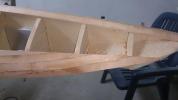You are not logged in.
- Topics: Active | Unanswered
Pages: 1
#1 25 Mar 2014 1:50 pm
- jbmerv
- Member
- Registered: 25 Mar 2014
- Posts: 24
Aleutesque build
I've built a High Capacity Great Auk, a micro Isfjord and a Petrel, and now I decided to try something a bit different, so I took the plunge and ordered a set of Aleutesque forms from Fyne Boats.
Much to my joy, I also got a full set of plans.
I started by making the internal stems, which are wildly different from the other kayaks I've made until now.
Starting in the way I mean to continue, I made both the bow and stern stem wrong, but fortunately realised before too long, and made another attempt.
I am uploading photos to Facebook as I go, but for some reason can't seem to link to them here.
Be warned, it takes me about a year to make a kayak!
I invested in an aluminium strongback for my first build, so I am now setting up the forms on it.
Justin
Offline
#2 25 Mar 2014 3:19 pm
- jbmerv
- Member
- Registered: 25 Mar 2014
- Posts: 24
Re: Aleutesque build
Hopefully a couple of pictures
Bow internal stems:

Incorrect stern internal stem (but it looks good):
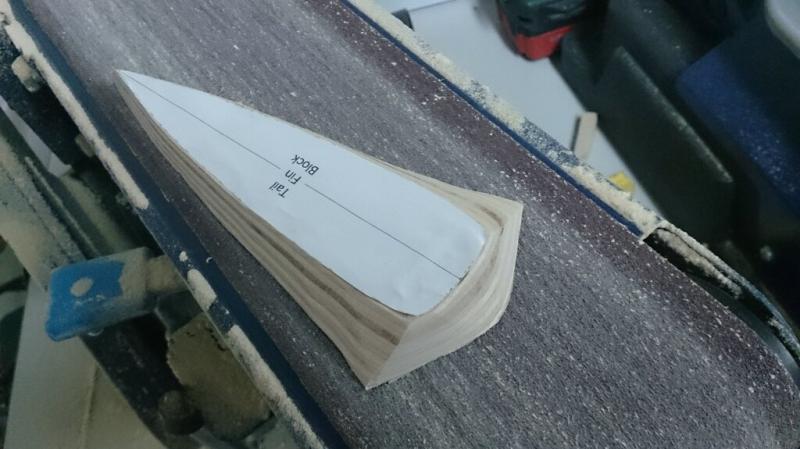
Correct stern internal stem:

The "Tail form, which had to be chopped into four pieces at an angle of 14 degrees!

Offline
#3 25 Mar 2014 9:32 pm
- wilddog
- Member
- From: Devon
- Registered: 22 Dec 2013
- Posts: 143
Re: Aleutesque build
If you look at my thread on my Skerry build, you'll see that the first thing that i did was make a mess of some simple carpentry. So you are not alone in having made a mess of things!
Built a Skerry!
Offline
#4 10 Apr 2014 7:27 pm
- jbmerv
- Member
- Registered: 25 Mar 2014
- Posts: 24
Re: Aleutesque build
After a bit of a mix-up with a few of the forms, the kind gentlemen at Fyne Boats sent me new ones, so I went at it with a will and got all the forms on the strong-back (piece of cake with an aluminium strong-back and CNC-cut forms) and even got the sheer strip hot-glued onto the forms.
Pictures to follow....
Offline
#5 11 Apr 2014 12:12 pm
- jbmerv
- Member
- Registered: 25 Mar 2014
- Posts: 24
Re: Aleutesque build
Pictures as promised!
Cutting the tabs of the forms:

Fixing the endforms. I had a bit of trouble, as so far on the boats I built I left the centre portion of the endform intact, and just cut a 3mm slot for the strongback, then used spacers and screwed through the whole thing.
But the CNC-cut forms have the portion inside the strongback cut out, so I ended with an horrible bodge, but it seems to work:


The great advantage of buying CNC-cut forms on an internal strongback is that setting up is easy, so a few minutes later I could start hot-gluing the sheer strip, and soon had the hint of the beginnings of what might one day be a boat!

The amount of twist at the ends is horrendous, but one advantage of building in cherry is that with a little steam assistance you can make bends like this:


The two ends are both horrendous, the stern is in fact impossible to make with the sheer strip, more on that later.


Any comments welcome!
Justin
Offline
#6 11 Apr 2014 1:47 pm
- wilddog
- Member
- From: Devon
- Registered: 22 Dec 2013
- Posts: 143
Re: Aleutesque build
Hats off to you for taking on what look like quite a complicated build!
Built a Skerry!
Offline
#7 22 Apr 2014 12:19 pm
- jbmerv
- Member
- Registered: 25 Mar 2014
- Posts: 24
Re: Aleutesque build
Made a little more progress over the long weekend.
I decided to change tactics a little on the stern, and cut off the strips in a straight line on the DWL
The bow is also coming along nicely, although I give daily thanks to the goddess of luck, who made me do this boat in easily-bendable cherry.
Hopefully once I get past the waterline it should be much more plain sailing.
Offline
#8 30 May 2014 4:05 pm
- Richard
- Member
- From: East Sussex
- Registered: 7 Jun 2011
- Posts: 75
Re: Aleutesque build
Thanks for posting this log. Since you started I have been looking closely at the Aleutesque (glad I do not have to pronounce it). It is a most intriguing kayak and I had not noticed how unusual it until you started. What was it that made you go for it?
How is the building going?
Canoe & Kayak Owner
Offline
#9 1 Jun 2014 8:27 am
- jbmerv
- Member
- Registered: 25 Mar 2014
- Posts: 24
Re: Aleutesque build
It was exactly how unusual it is that attracted me to it, but I worried a bit about how hard it would be to build. Now I know that I was right to worry!
I like unusual-looking kayaks (I own a Point65 XP18, and adore it's looks) but I am both a bit fat and rather inexperienced, so the Aleutesque may be too much for me. Although the Petrel is an absolute joy, and actually feels far more stable than the XP18.
Progress has been very slow recently, mainly because I only have time at the weekends for building, and I have been kayaking for the last three weekends.
Also I don't want to fill this up with hundreds of "more infinitesimal progress" posts!
Offline
#10 21 Jul 2014 8:26 pm
- jbmerv
- Member
- Registered: 25 Mar 2014
- Posts: 24
Re: Aleutesque build
Managed to find a couple of days to do some work, finished stripping the hull, scraped the dried glue off, and rough-sanded one side.

The bow

Unusual, but stunningly beautiful lines

The stern.
Definitely enjoying this build, and not (quite) as hard as I feared.
Offline
#11 17 Jan 2015 11:44 am
- jbmerv
- Member
- Registered: 25 Mar 2014
- Posts: 24
Re: Aleutesque build
Very long gap since my last post!
The deck was generally very easy to build, except the stern, where it swoops down to the waterline at the sides, and has a ridge in the middle.

Once again every strip had to be steam-bent, and some creative clamping was needed:

The end result was quite good, though I says it myself. There will be a hard-wood block for the very end
I then separated the hull and deck from the forms, splitting the deck near the bow in the process!, but it glued back together no problem, and then fibre-glassed inside and out.

There is a very strange shape at the bow end of the hull, and when I started fibreglassing the inside I decided that it would be nearly impossible to do a good job, so I filled the whole space

I added polystyrene foam to the epoxy fill, to make it as light as possible
Offline
#12 17 Jan 2015 12:02 pm
- jbmerv
- Member
- Registered: 25 Mar 2014
- Posts: 24
Re: Aleutesque build
I decided to make a recessed cockpit rim, partly to keep the very low, clean lines of the kayak intact, and partly because I have never made one before!
I made up a blank for the recess out of foam covered with packing tape, fixed it to the underside of the deck with double-sided tape, and prepared all the cloth I would need.

The lay-up was a layer of 4-ounce cloth, a layer of carbon fibre cloth (for bling and to make the whole thing opaque) and then ten more layers of 4-ounce cloth!
This is where more professional builders would attach the vacuum bag, switch on the vacuum and then go and have a relaxed cup of tea, but I don't have a vacuum pump, so I used the poor man's equivalent

Wet Sand!

It actually came out reasonably well, with only a couple of voids - good enough for me!
Then came the really nail-biting bit, where I had to cut out the recess for the spray-deck, praying that I was cutting in the right place

As you can see, the cut is through the deck into the foam blank below, I did this with a router and sweat!

I then cleaned out the foam from the recess, and went and had a celebratory beer. The only real problem I had was the carbon-kevlar cloth I used to re-inforce the deck around the cockpit, which incredibly even a router won't cut cleanly
Offline
#13 18 Jan 2015 1:43 pm
- jbmerv
- Member
- Registered: 25 Mar 2014
- Posts: 24
Re: Aleutesque build
I decided to use magnets to hold the hatch covers, a method I've used before and been happy with, but this time I made separate rings to hold the magnets, and glued them to the hatch covers. Previously I drilled holes into the hatch covers for the magnets, but that is a bit hair-raising since the hole needs to be 3mm deep in a 5mm thick cover.

This time I used 3mm thick HDF board, and it was a much more relaxed process

This shows how it goes on the cover

Glued on. I put a single layer of 4oz cloth over the upper face, to protect the HDF and hold the magnets

I glued a thin strip of wood around the edge, protruding 2mm, which will be the sealing surface against the gasket - hopefully this will give a better seal than a wider area with proportionately less force
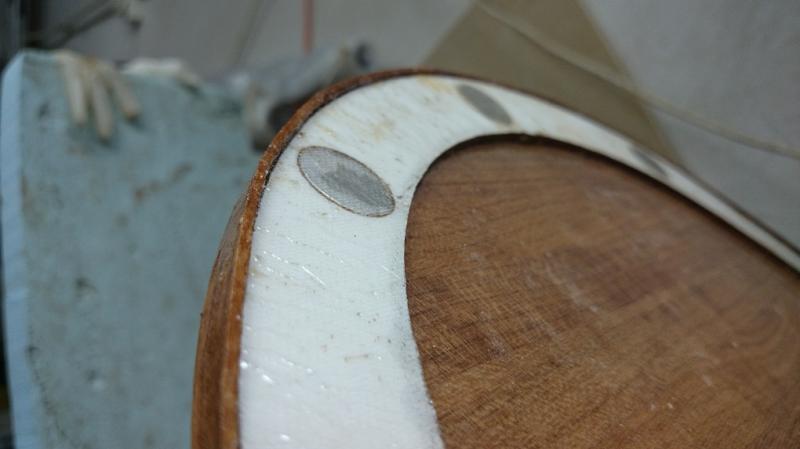
All looking quite smart, really.
To hold the hatch covers I put two spacer rings of HDF and a base ring, thin plywood for the stern hatch, HDF for the bow hatch.

The stern hatch can get a lot of abuse during rescues etc, so I though the plywood would be stronger

The bow hatch is not flat, and is less likely to have someone sit on it, so I used the easier to cut and cheaper HDF
Offline
#14 18 Jan 2015 1:56 pm
- jbmerv
- Member
- Registered: 25 Mar 2014
- Posts: 24
Re: Aleutesque build
For the perimeter lines and deck cords I decided to use Maroske fittings, which are basically a little tunnel under the deck.

I first drilled over-sized holes and filled them with thickened epoxy.
After the epoxy fully hardened the final size holes were drilled. This ensures that water cannot get to the wood around the holes.
The proper way is then to use fibreglass tubing to make a little sleeve around some nylon or plastic tubing, then soak it in epoxy and pull out the plastic tube. However I saw an easier way, which is to simply make a little mound of thickened epoxy over the tube, then put a square of fibreglass over that

It worked beautifully. I managed to get hold of latex tubing, and it came out once the epoxy was dry with just a little tug.
Offline
#15 18 Jan 2015 6:42 pm
- jbmerv
- Member
- Registered: 25 Mar 2014
- Posts: 24
Re: Aleutesque build
I also put a skeg in, since Nick Schade's designs tend to be quite loose tracking, and a skeg is much harder to retro-fit once the deck is joined to the hull.

The end of the hull is really very shallow, the skeg will only fit because of the ridge in the deck

I cut the slot for the skeg with my trusty router, and glued the skeg in with thickened epoxy, it was a quick and easy job.
Offline
#16 18 Jan 2015 6:54 pm
- jbmerv
- Member
- Registered: 25 Mar 2014
- Posts: 24
Re: Aleutesque build
Because the ends of this boat are so thin, I wasn't sure I would be able to reach them for taping the inside seam and decided to put sheer-clamps in the ends. These are small wood strips to increase the area of contact between the deck and hull.

First I put a couple of tiny ones in at the stern, this would not normally be necessary, but the design of this boat is really unique

Then I added sheer-clamps from the last Maroske fitting to the stern
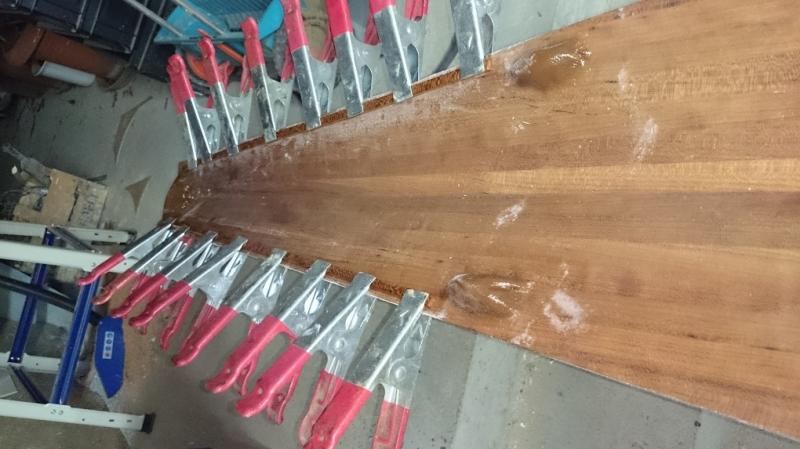
and the bow. You can never have too many clamps!
Once the epoxy had hardened I spread a bit of thickened epoxy on the sheer-clamps, wrestled the deck into position and clamped it
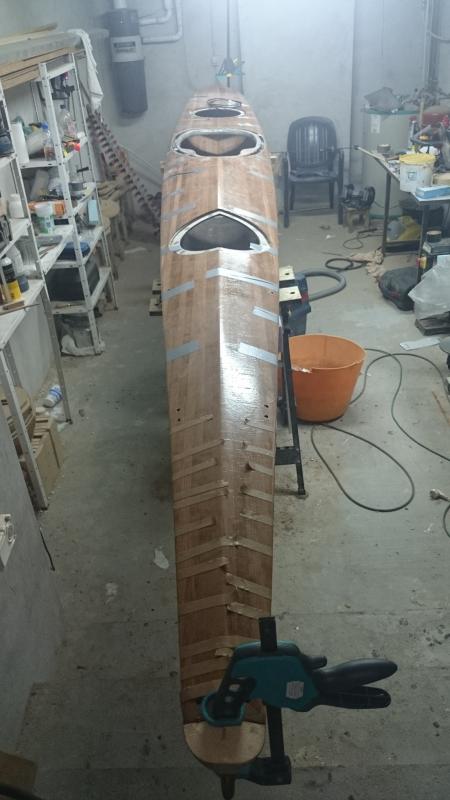
Again I waited until the epoxy hardened, then tipped the boat on its side and used duct-tape to fix the deck to the hull. The hull was a pretty good fit, since I took care to put spreader sticks on the hull while I was fibre-glassing it and making the deck.

Then I taped the seam inside and out (I also added a fillet of thickened epoxy to the inside seam) and that is where I am today!
Just a bit of fibre-glassing around the cockpit and the bulkheads still to do.
Offline
#17 19 Jan 2015 5:28 pm
- Ian
- Employee

- Registered: 24 Nov 2014
- Posts: 103
Re: Aleutesque build
Your way of making Maroske fittings does sound a bit quicker than mine, though the 'proper way' doesn't actually take very long once you've worked out all the details of making them and got all the bits and pieces you need. We're thinking of putting together a kit for making them, with complete instructions. But it was quite fun working it out for myself.
Did you make the retractable skeg from scratch too?
Offline
#18 19 Jan 2015 6:35 pm
- jbmerv
- Member
- Registered: 25 Mar 2014
- Posts: 24
Re: Aleutesque build
The main problem was sourcing fibreglass tubing, I couldn't find anything smaller than 20mm here in Hungary. A kit for Maroskes sounds like a very good idea to me, they are almost the perfect fitting in my opinion, their only disadvantage is that they need planning and can't be retro-fitted. I would really recommend that you supply latex tubing, it came out with just a little tug.
I'm afraid the skeg is a kayaksport one, I'm planning on trying Uncle Nick's design on my next build
Offline
Pages: 1

